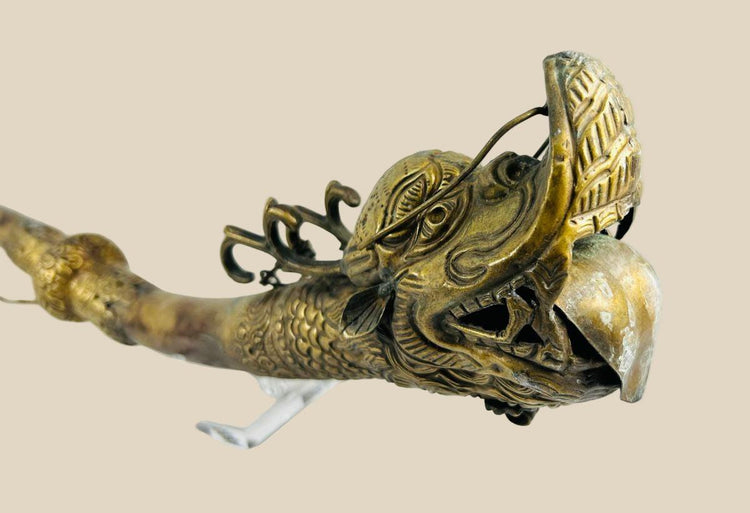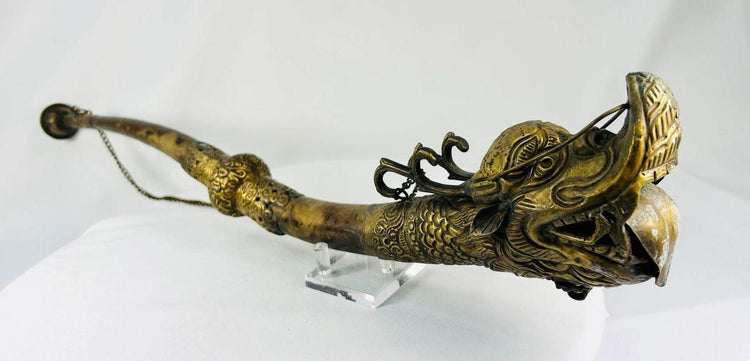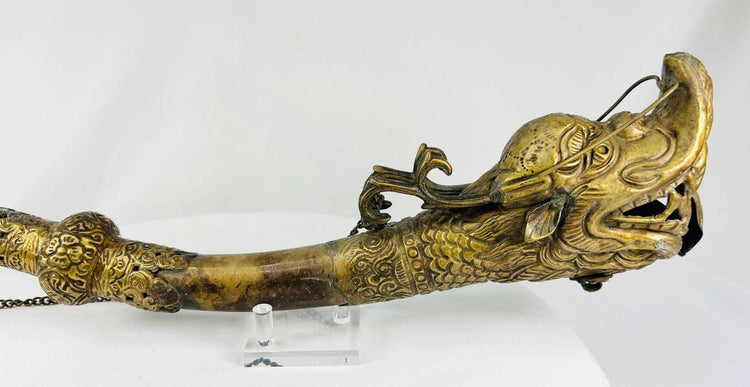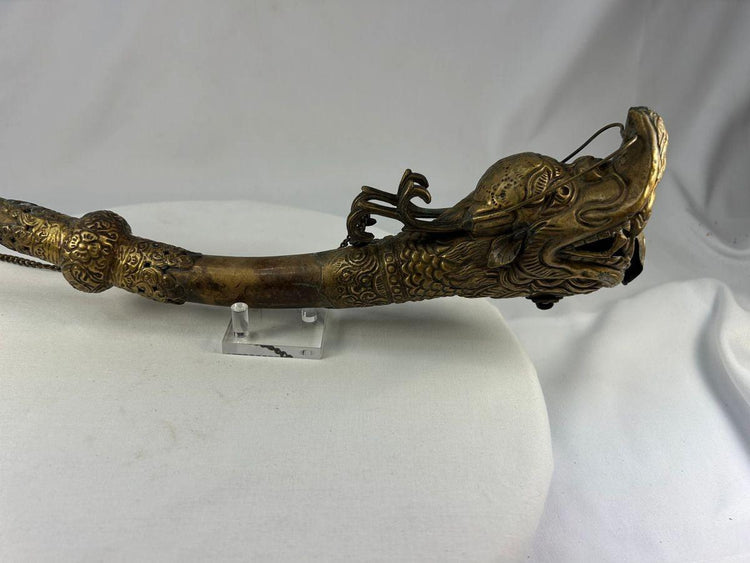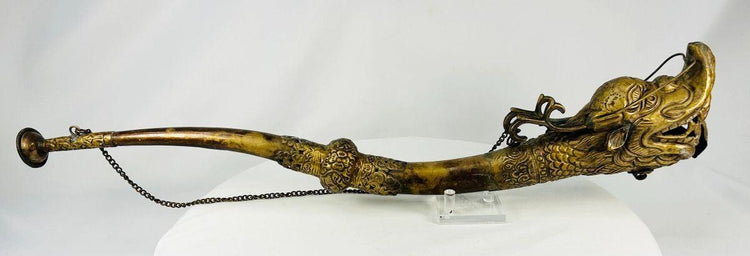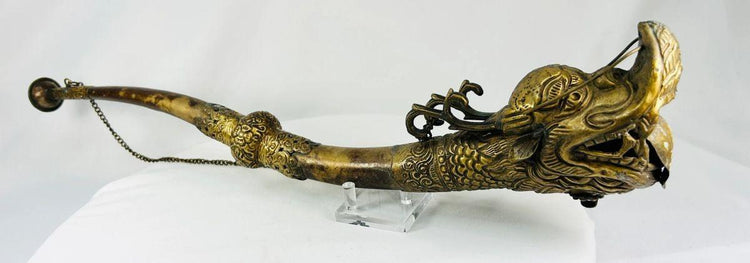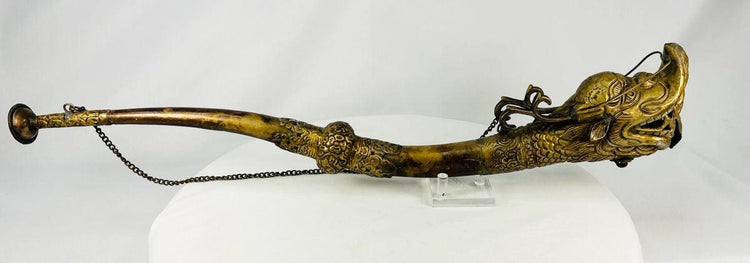Qing-Era Tibetan Ritual Horn | Gilt Bronze Dragon-Head Trumpet with Relief Decoration | Late 18th–Early 19th Century
Description
More
Less
Historical Context & Origin
Region: Tibet / Himalayan Region (with Qing Dynasty Chinese influence)
Material: Gilt bronze with chain links
Period: Late 18th to Early 19th Century (circa 1780–1830, Qing Dynasty)
Description
This extraordinary Tibetan ritual trumpet features an elaborately cast dragon’s head forming the bell, adorned with stylized flames, curling horns, and finely detailed teeth and eyes. The body is slightly arched, decorated with ornate relief patterns of waves and florals, and retains its original chain attachment—underscoring its authenticity and ceremonial function. Ritual horns of this type were used in Buddhist monastic practice to invoke deities, call spirits, and accompany temple rites. The dragon motif reflects imperial Chinese influence over Tibet during the Qing period, symbolizing divine authority and protection.
Features
- Hand-cast gilt bronze trumpet with dragon-head bell
- Pierced and sculpted detailing: eyes, horns, and fangs
- Ornamental relief designs of clouds, florals, and wave motifs
- Original chain intact and attached
- Slightly curved body for practical use in processions
- Rich patina with traces of gilding from centuries of ceremonial use
Cultural Significance
In Tibetan Buddhism, ritual instruments like this trumpet (commonly known as dung-dkar or dung-dkarling) were essential in monastic life, especially during large ceremonies and processions. The dragon imagery imbues the piece with associations of imperial power, cosmic protection, and spiritual energy, reflecting the strong interplay of Chinese and Tibetan artistic traditions during the Qing era.
Condition
Excellent antique condition. Natural age patina with areas of gilt loss and tarnishing consistent with ritual use. No structural cracks or repairs. Retains its full ceremonial presence.
Dimensions (approximate)
Length: 21 in
Height (at dragon head): 4.25 in
Age
Estimated late 18th to early 19th century (Qing Dynasty, circa 1780–1830)
Description
Historical Context & Origin
Region: Tibet / Himalayan Region (with Qing Dynasty Chinese influence)
Material: Gilt bronze with chain links
Period: Late 18th to Early 19th Century (circa 1780–1830, Qing Dynasty)
Description
This extraordinary Tibetan ritual trumpet features an elaborately cast dragon’s head forming the bell, adorned with stylized flames, curling horns, and finely detailed teeth and eyes. The body is slightly arched, decorated with ornate relief patterns of waves and florals, and retains its original chain attachment—underscoring its authenticity and ceremonial function. Ritual horns of this type were used in Buddhist monastic practice to invoke deities, call spirits, and accompany temple rites. The dragon motif reflects imperial Chinese influence over Tibet during the Qing period, symbolizing divine authority and protection.
Features
- Hand-cast gilt bronze trumpet with dragon-head bell
- Pierced and sculpted detailing: eyes, horns, and fangs
- Ornamental relief designs of clouds, florals, and wave motifs
- Original chain intact and attached
- Slightly curved body for practical use in processions
- Rich patina with traces of gilding from centuries of ceremonial use
Cultural Significance
In Tibetan Buddhism, ritual instruments like this trumpet (commonly known as dung-dkar or dung-dkarling) were essential in monastic life, especially during large ceremonies and processions. The dragon imagery imbues the piece with associations of imperial power, cosmic protection, and spiritual energy, reflecting the strong interplay of Chinese and Tibetan artistic traditions during the Qing era.
Condition
Excellent antique condition. Natural age patina with areas of gilt loss and tarnishing consistent with ritual use. No structural cracks or repairs. Retains its full ceremonial presence.
Dimensions (approximate)
Length: 21 in
Height (at dragon head): 4.25 in
Age
Estimated late 18th to early 19th century (Qing Dynasty, circa 1780–1830)
You May Also Like




















